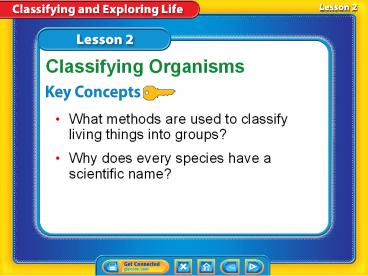Lesson 2 Reading Guide - PowerPoint PPT Presentation
Title:
Lesson 2 Reading Guide
Description:
Classifying Organisms What methods are used to classify living things into groups? Why does every species have a scientific name? Lesson 2 Reading Guide – PowerPoint PPT presentation
Number of Views:121
Avg rating:3.0/5.0
Title: Lesson 2 Reading Guide
1
Lesson 2 Reading Guide
Classifying Organisms
- What methods are used to classify living things
into groups? - Why does every species have a scientific name?
2
Lesson 2 Reading Guide - Vocab
Classifying Organisms
- binomial nomenclature
- species
- genus
- dichotomous key
- cladogram
3
Lesson 2
Classifying Living Things
- There have been many different ideas about how to
organize, or classify, living things. - Carolus Linnaeus classified organisms into two
main groups, called kingdoms, based on similar
structures.
4
Lesson 2
Determining Kingdoms (cont.)
kingdom Science Use a classification category
that ranks above phylum and below domain Common
Use a territory ruled by a king or a queen
5
Lesson 2
Determining Domains
- The current classification method for organisms
is called systematics. - Systematics uses all known evidence to classify
organisms, including cell type, how food and
energy are obtained, structure and function of
features, common ancestry, and molecular analysis.
6
Lesson 2
Determining Domains (cont.)
- Organisms are now classified into one of three
domains and then into one of six kingdoms.
7
Lesson 2
Determining Domains (cont.)
What evidence is used to classify living things
into groups?
8
Lesson 2
Scientific Names
- Binomial nomenclature is a system for naming
organisms with two-word scientific name - A species is a group of organisms that have
similar traits and are able to produce fertile
offspring. - A genus is a group of similar species.
9
Lesson 2
Scientific Names (cont.)
genus from Greek genos, means race, kind
10
Lesson 2
11
Lesson 2
Scientific Names (cont.)
- Binomial nomenclature was developed by Linnaeus
and is still used today. - Scientific names are important because each
species has its own scientific name and those
names are the same worldwide.
12
Lesson 2
Scientific Names (cont.)
Why does every species have a scientific name?
13
Lesson 2
Classification Tools (cont.)
- A dichotomous key is a series of descriptions
arranged in pairs that lead the user to the
identification of an unknown organism.
14
Lesson 2
Classification Tools (cont.)
- A cladogram is a branched diagram that shows the
relationships among organisms, including common
ancestors.
15
Lesson 2
- All organisms are classified into one of three
domains Bacteria, Archaea, or Eukarya.
16
Lesson 2
- Every organism has a unique species name.
17
Lesson 2
- A dichotomous key helps to identify an unknown
organism through a series of paired descriptions.
18
Lesson 2
How many scientific names does each organism have?
A. 1 B. 2 C. 3 D. Many
19
Lesson 2
Which of these refers to the system for naming
organisms with two identifying scientific terms?
A. genus B. cladogram C. binomial
domains D. binomial nomenclature
20
Lesson 2
Which of these refers to a series of descriptions
arranged in pairs that help identify an unknown
organism?
A. dichotomous key B. domain C. cladogram D. genus
21
Lesson 2
Do you agree or disagree?
- 3. A dichotomous key can be used to identify an
unknown organism. - 4. Physical similarities are the only traits used
to classify organisms.































